|
British
Columbia Passenger License Plates
|
|||||||||||||||||||||||||||||||||||||||||||||||||||||||||||||||||||||||||||||||||||||||||||||||
Quick Links: |
BC license plates issued in 1930 are part of the "Patronage Era" (1918-30) in which the contract for the production of the plates went to politically connected firms. |
* * * * * |
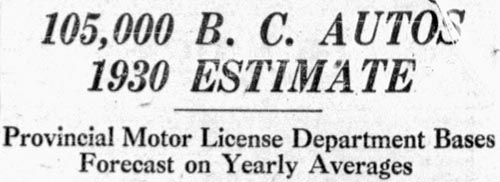 |
At the beginning of 1929, there was no reason to believe that the roaring growth in automobile ownership and vehicle registrations that had occurred over the course of the previous decade wouldn't continue. |
Accordingly, when preparing the Tender for the 1930 license plate contract, the Provincial Police estimated an 11% growth rate, or an additional 10,000 vehicles on the road. As there had been approximately 94,299 registrations in 1928, this suggested the need for 105,000 set of passenger license plates. |
 The Tolmie Victory - July of 1928 |
While the election had occurred too late in the year to affect the awarding of the contract for the 1929 license plate order - which went to J.R. Tacey & Son again - it would have significant implications for the 1930 contract. |
The Company: Thompson Heating & Ventilating |
Interstingly, not as much is known about the Thompson Heating & Ventilating Company in comparison to what is known of J.R. Tacey & Son, who preceded Thompson in making license plates for the province. George B. Thompson, the President of the company does not appear to have advertised often or been listed in the local city directories, nor does it appear that he or his company were ever profiled by the local press in the same way as Tacey. What is important to know about George B. Thompson is that, like Tacey he was also active in local Vancouver politics albeit it for the Conservative Party. This included being President of the Ward Eleven Conservative Association in Vancouver as well as an appointment as a Provincial Elections Commissioner in 1929. Consequently, when the Conservative Party won office at the provincial level in 1928 and had the ability to influence the awarding of various contracts, companies such as Thompson's stood to benefit. Not surprisingly, when the awarding of the 1930 license plate contract was announced, Thompson Heating & Ventilating Company won with a bid that was precisely half-a-cent less per pair of plates than what Tacey had bid to win the 1929 contract; $0.135/pair versus $0.14/pair by Tacey.
|
It was further reported that "on December 1 [of 1929], the staff at the [Vancouver] Courthouse will commence issuing 1930 plates to motorists in posession of 1929 licenses. This accommodation, however, is limited to renewals. Otherwise, the new license plates will be on sale a day or two before Christmas." Even though some motorists could pick-up their plates from the beginning of December, it was prohibited to attach the plates to a car prior to January 1st. Plates numbered 1 to 21,000 were to be retained at the headquarters of the Provincial Police in Victoria for issuance in the Capital City as well as by mail to motorists throughout the province. |
| 1930 | 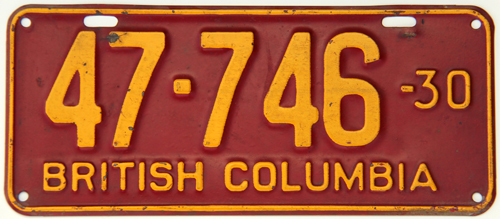 |
|
||||||||||||||||
| Gallery | 1-digit
|
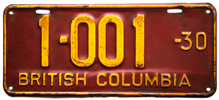 |
|
 |
The inspiration for the yellow-on-red colour scheme selected to inaugurate Thompson's initial license plate design is long-lost now, however, at the time it certainly engendered comment in the local press, even earning the rare treatment of a dedicated "funnies" (aka comic strip). The Vancouver Province referred to the colour as "the gay red and yellow markers" while the Victoria Daily Times reported that the colours would be "light red and the numerals, letters and borders will be faced with a pleasing citrus yellow, making a striking combination." The Vancouver Sun went a step further, declaring "the license plates for 1930 are regarded as the most attractive of any issued by the department [emphasis added], having a wine-red background with cream numerals." |
An additional criticism was that "many motorists have found considerable trouble in fitting their new plates to the holders on their car owing to the plate bolt slots being half an inch shorter than usual This has necessitated boring quarter-inch holes into the plates." |
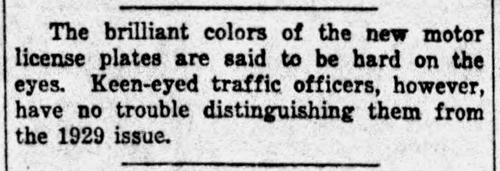 A reminder to motorists in January of 1930 to get their new license plates! |
* * * * * |
||||
So, how does a company with no experience making license plates or the machinery to do so win a contract and produce the largest order of license plates the province had ever requested (215,000+ individual plates) in the span of only 6 months? At first glance, it was believed that Thompson followed the same path that Tacey had blazed 12 years earlier by reaching out to a different company to purchase license plate equipment at a reported cost of $6,000. By early January of 1930, however, this question was revisited after the province announced it had purchased J.R. Tacey & Son's equipment in order to move production to Oakalla Prison in Burnaby (see the next section on the 1931-1935 plates for more details). Why would a Conservative government purchase the equipment of a Liberal affiliated company (Tacey) when it could have rewarded one of its own (Thompson) by buying their equipment and offering a lucrative services contract? On January 11, 1930, the Vancouver Sun opined, rather knowingly, that "there is a general feeling that a statement as to whether the 1930 plates were made in B.C. or elsewhere would be prove interesting." [emphasis added] The first to take up the challenge was Thomas Uphill, Independent Labour Party member for Fernie, who, on March 5, 1930, rose in the Legislature and asked the Conservative Attorney General Robert Pooley where the 1930 license plates had been manufactured. Pooley's response was a very evasive sounding: "no definite information." |
||||
|
||||
The Liberal opposition took up the matter two weeks later on March 18, 1930, when Ian McKenzie, MLA for North Vancouver rose to ask Pooley the following; "were motor-licence plates for the year 1930 completely manufactured within the Province? If not, why not?" Pooley's response remained unchanged; "no definite information." |
||||
|
||||
As the rules of the Legislature prevented Pooley from misleading the house (i.e. no lying), his inability to answer such straight-forward questions raises a whole suite of interesting scenarios: |
|
|
|
|
|
Unfortunately, we have no answers to these questions and while a license plate's dies can sometimes act as a fingerprint and be used to trace the origin of a particular plate's place of manufacture, the dies used on the 1930 plates appear to have been "one-and-done" and never used anywhere else. |
| The Premier's Plate |
Throughtout the 1920s, increases in vehicle ownership and registration numbers were considered to be a marker of economic growth and prosperity in the province. For instance, in 1929, the local press lauded that "British Columbia ... is keeping abreast of Ontario in per capita ownership of cars, these two provinces leading the entire Dominion."
After the Conservative victory in 1928, Premier Tolmie stepped in and adopted this practice for himself, claiming the No. 105-000 in 1930. |
* * * * * |
 Vancouver Province Headline - October 24, 1929 |
At the beginning of 1929, when the Tender for the 1930 license plates had been released, there was no reason to believe that the roaring growth in automobile ownership and vehicle registrations that had occurred over the course of the previous decade wouldn't continue (e.g. 10%/year). |
Following the "Wall Street Crash" in the Fall of 1929, motor vehicle registrations began to stagnate. The anticipated 100,000 registrations that year (1929) never materialized with the total coming in at 94,299. |
Similarly, the optimism that there would be 105,000 registrations in 1930 gave way to the reality of only 97,586, or a 3.5% increase over 1929. |
| Thompson Heating & Ventilating Company: Postscript |
Not only did the province announce that it was taking over the production of license plates by setting up its own shop at Oakalla Prison in Burnaby, thereby depriving Thompson's company of a lucrative government contract at a time when the economic situation continued to deteriorate. But, it was doing so with the assistance of his main competitor; J.R. Tacey & Son whose equipment it had contracted to buy along with training of Oakalla staff by Tacey's employees. This would render Thompson's plate making equipment virtually worthless - if it existed (see the next section on the 1931-1935 plates for more details). 18 months later, Thompson would be dead at the age of 41 following a collision between the truck he was driving and a street car crossing the Granville Street bridge on July 6, 1931. Local press reports from the time indicate that Thompson and a passenger were crossing the bridge at 11:25 p.m. when they collided with the street car "240 feet north of the Third Avenue ramp on Granville Street bridge." The passenger was tossed from the vehicle and survived but Thompson's body was pinned beneath the wreckage and "practically decapitated". The police reported that Thompson's truck had been heading south across the bridge, likely back to his business premises at 1507 West 4th Avenue when it was "telescoped" by a north bound street car (i.e. the truck went under the chassis of the street car). As can be seen in the image below, the Granville Street bridge at this time accommodated two street car lines (one north, the other south) which shared lanes with vehicle traffic using the bridge. The Third Avenue ramp can be seen near the two big billboards at left: |
Given street cars ran on fixed lines, it would appear that Thompson had drifted into on-coming traffic and was likely at fault. As can be seen in the following illustrative examples, collisions between street cars and vehicles did not usually end well for the drivers of vehicles given the size differential between the two: |
Apart from the obvious tragedy of the incident, there seems to be a bitter irony to it as well, given Thompson shuffled off this mortal coil driving a vehicle that would have displayed 1931 license plates made at Oakalla instead of at his own shop, made with equipment purchased by a Conservative government from his Liberal competitor, and displaying the curved dies most associated with J.R. Tacey & Son license plates. |
| Out of curiosity, we here at BCpl8s.ca took a look on Google Earth to see what had become of the location where Thompson once had his business. It is now wedged between the Granville Street Bridge (rebuilt long after Thompson died on it) and the 4th Avenue off-ramp. At some point, the site was razed and paved for vehicle parking: |
 |
Quick Links: |
Antique | APEC | BC Parks | Chauffeur Badges | Collector | Commercial Truck | Consul | Dealer | Decals | Driver's Licences | Farm | Ham Radio | Industrial Vehicle | Keytags | Lieutenant Governor | Logging | Manufacturer | Medical Doctor | Memorial Cross | Motive Fuel | Motor Carrier | Motorcycle | Movie Props | Municipal | National Defence | Off-Road Vehicle | Olympics | Passenger | Personalized | Prorated | Prototype | Public Works | Reciprocity | Repairer | Restricted | Sample | Special Agreement | Temporary Permits | Trailer | Transporter | Veteran | Miscellaneous |
© Copyright Christopher John Garrish. All rights reserved.

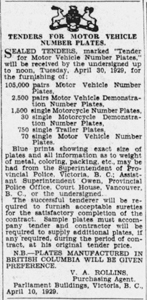
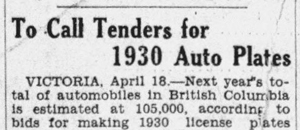 Specifications for the 1930 plates were available from the Superintendent of Provincial Police, upon request, sample plates were to accompany all tenders, and plates manufactured in British Columbia were, once again, to be given preference over out-of-province proposals.
Specifications for the 1930 plates were available from the Superintendent of Provincial Police, upon request, sample plates were to accompany all tenders, and plates manufactured in British Columbia were, once again, to be given preference over out-of-province proposals.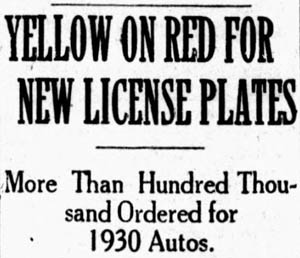 On November 11, 1929, it was reported that the 1930 license plates were being delivered to the various field offices of the Provincial Police and were described as "presenting a striking contrast in colors ... [having] yellow figures on a red background."
On November 11, 1929, it was reported that the 1930 license plates were being delivered to the various field offices of the Provincial Police and were described as "presenting a striking contrast in colors ... [having] yellow figures on a red background."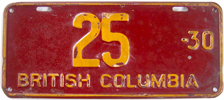
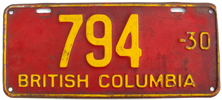

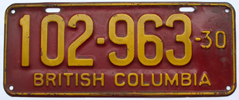
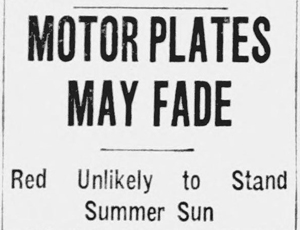

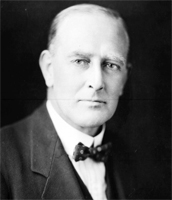
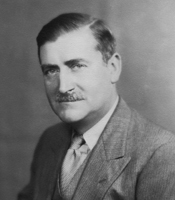
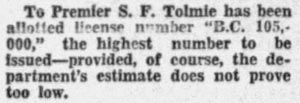 To trumpet these accomplishments, the Liberal Attorney General Alexander Manson had reserved the highest numbered plate produced (in the initial order) for use on his vehicle, such as the No. 80-000 in 1927 and the No. 90-000 in 1928.
To trumpet these accomplishments, the Liberal Attorney General Alexander Manson had reserved the highest numbered plate produced (in the initial order) for use on his vehicle, such as the No. 80-000 in 1927 and the No. 90-000 in 1928.  Fate does not appear to have been looking kindly on George Thompson as the calendar rolled over to a new decade on January 1, 1930.
Fate does not appear to have been looking kindly on George Thompson as the calendar rolled over to a new decade on January 1, 1930. 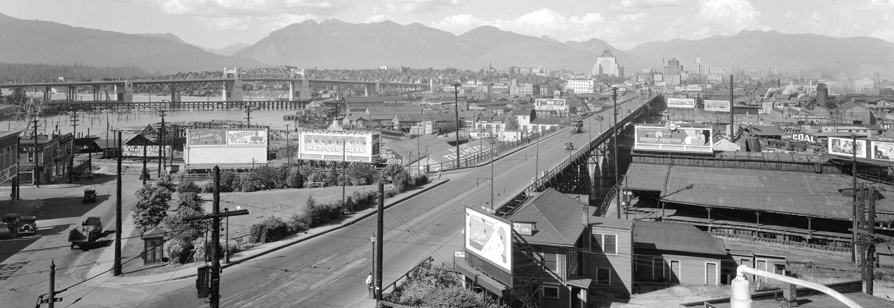
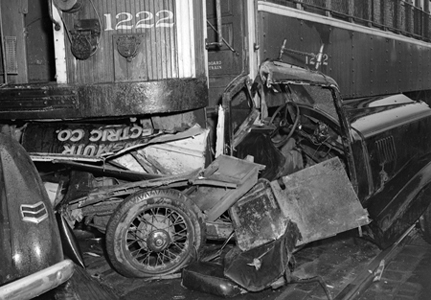
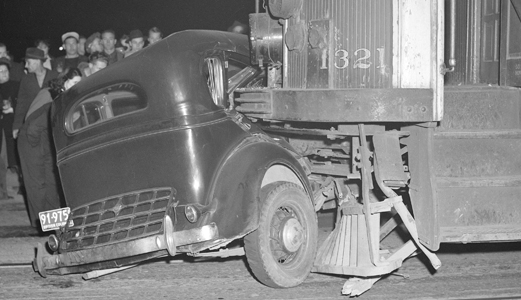
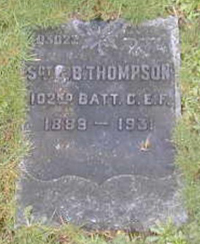 Thompson left behind his wife (reported to be "in a state of collapse" the night of the accident) and five children and, like Tacey, he is also buried in Vancouver's Mountain View Cemetery.
Thompson left behind his wife (reported to be "in a state of collapse" the night of the accident) and five children and, like Tacey, he is also buried in Vancouver's Mountain View Cemetery.